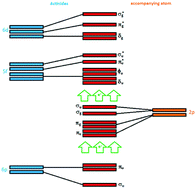Assessing the accuracy of simplified coupled cluster methods for electronic excited states in f0 actinide compounds†
Abstract
We scrutinize the performance of different variants of equation of motion coupled cluster (EOM-CC) methods to predict electronic excitation energies and excited state potential energy surfaces in closed-shell actinide species. We focus our analysis on various recently presented pair coupled cluster doubles (pCCD) models [J. Chem. Phys., 2016, 23, 234105 and J. Chem. Theory Comput., 2019, 15, 18–24] and compare their performance to the conventional EOM-CCSD approach and to the completely renormalized EOM-CCSD with perturbative triples ansatz. Since the single-reference pCCD model allows us to efficiently describe static/nondynamic electron correlation, while dynamical electron correlation is accounted for a posteriori, the investigated pCCD-based methods represent a good compromise between accuracy and computational cost. Such a feature is particularly advantageous when modelling electronic structures of actinide-containing compounds with stretched bonds. Our work demonstrates that EOM-pCCD-based methods reliably predict electronic spectra of small actinide building blocks containing thorium, uranium, and protactinium atoms. Specifically, the standard errors in adiabatic and vertical excitation energies obtained by the conventional EOM-CCSD approach are reduced by a factor of 2 when employing the EOM-pCCD-LCCSD variant resulting in a mean error of 0.05 eV and a standard deviation of 0.25 eV.

- This article is part of the themed collection: 2019 PCCP HOT Articles


 Please wait while we load your content...
Please wait while we load your content...